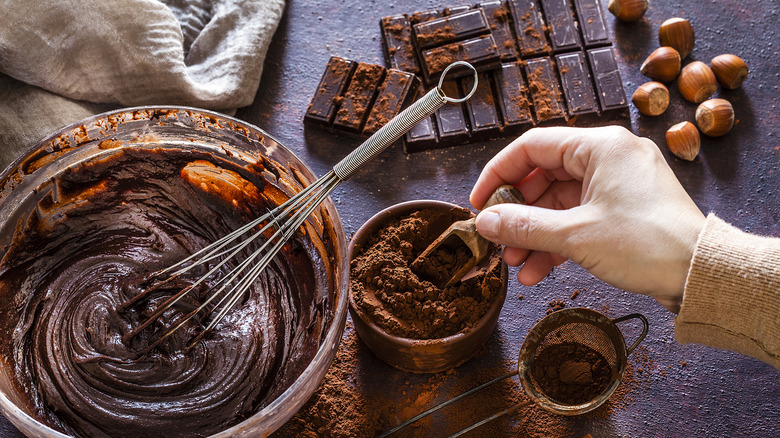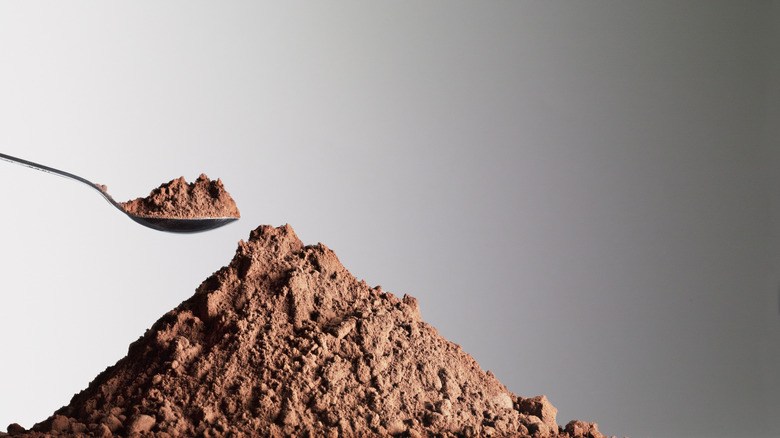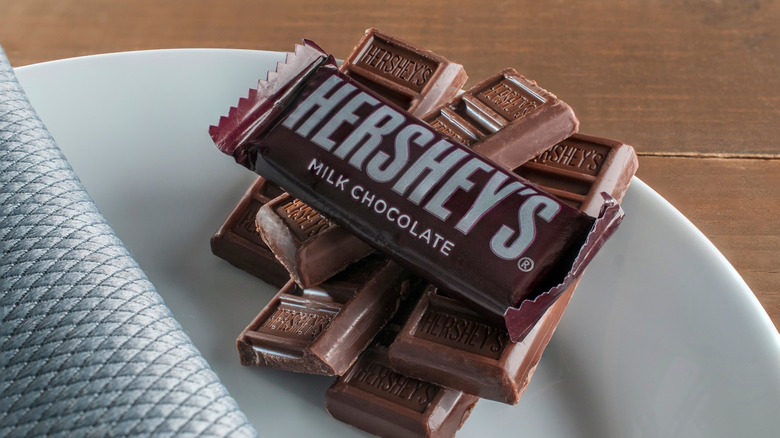The Best Substitute For Baking Chocolate In A Pinch
Whether making a fudgy batch of brownies, a rich, old-fashioned chocolate pudding, or any other decadent, chocolate-laden dessert, baking chocolate is an essential ingredient. Chocolate is high in cocoa solids, giving it a rich, pure flavor. With help from the cocoa butter, baking chocolate guarantees a chocolatey, fudgy end product. However, not every home baker has baking chocolate handy at all times.
If you are in the middle of baking and find yourself needing but not having baking chocolate, you do not have to panic. A combination of two or three pantry staples can meet your baking chocolate needs and allow you to continue crafting your chocolaty confection. Those pantry staple ingredients are cocoa powder, oil or butter, and sometimes sugar. With a few simple conversions and a willingness to take the extra steps, your makeshift baking chocolate substitute will be indistinguishable from the real stuff in your final dish.
How cocoa powder and oil get the job done
Cocoa powder is a viable replacement for baking chocolate when paired with vegetable oil or butter. After all, cocoa powder is ground-up cocoa solids, and vegetable oil and butter are both types of fat. Baking chocolate is comprised of cocoa solids and cocoa butter, another type of fat. A combination of cocoa powder and oil/butter will essentially give you the same product as pure baking chocolate. If your recipe calls for sweetened baking chocolate, be sure to mix in some sugar, too.
As for exact substitutions, the ratio rule is simple — for every 10 grams of baking chocolate, use 1 tablespoon of cocoa powder and 1/3 tablespoon of vegetable oil or butter. So, for instance, if your recipe calls for 30 grams of baking chocolate, you can swap in 3 tablespoons of cocoa powder and 1 tablespoon of vegetable oil or butter. Following the same ratio, if your recipe calls for 100 grams of baking chocolate, use 10 tablespoons of cocoa powder and 3.3 tablespoons of your preferred fat.
Would a candy bar do the trick?
While baking chocolate may appear similar to a run-of-the-mill chocolate bar, like Hershey's or Lindt, their components are very different from one another and should not be used interchangeably. If you bite into a bar of baking chocolate, your expectation for a sweet, silky taste will be quickly overtaken by something more bitter and overpowering.
There are many distinct types of chocolate and ways to use them, and that distinction definitely applies to baking chocolate. It is pure chocolate — cocoa solids and cocoa butter. Even if it is semi-sweet, it will still be comprised of around 56-70% cocoa. For comparison, a Hershey's Special Dark Chocolate bar, which contains high amounts of milk and sugar, contains only 45% cocoa. If you use this in your baking, the chocolate flavor will come through but not as strongly. Rather than for baking, consider using a chocolate candy bar to level up your next hot chocolate.
If you looking to use a chocolate candy bar, opt for a chocolate with a high cocoa percentage and consider the amount of sugar the bar brings to the recipe. Still, cocoa powder and vegetable oil/butter make the most ideal baking chocolate replacement.


